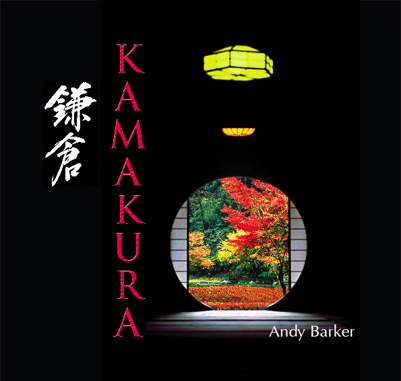
The front cover of Andy Barker's Kamakura. (Photo copyright Andy Barker and taken from photospace b)
Kamakura by Andy Barker
photospace b books
avaliable from Amazon.
An autographed copy is available from the author.
Contact Andy Barker
(Disclosure: Your humble editor has known Andy Barker for several years and even studied photography in his many classes. He agreed to review the book as a friend and post the review, along with this disclosure, only if he liked what he saw.)
At first glance, Andy Barker's Kamakura contains all the obvious elements expected in a photobook about Japan: Lots of colorful costumes, men carrying portable shrines during festivals, women in kimono, artistic and moody shots of temples, trees and buildings, and random bits of architectural detail.
Then, on page 14, there's a photo of hollyhock in front of a moving train. The photo is jarring for it's plainness, especially as it follows an impressive triptych of a sunset behind Mount Fuji. Except for the bright colors of the flowers the photo lacks an obvious center of focus. The background is cluttered with railway poles and cables and a yellow, triangular caution sign steals focus from the flowers. Taken by itself, the photograph would seem to be an accidental snap taken in the days of film as the photographer was advancing his film counter to one or a snap taken by an amateur who didn't notice the background. It's the kind of photograph people keep in a shoe box along with blurry shots of lights and accidental photos of the ground, until they get around to throwing them out years later.
On the facing page there's a photo of men carrying a portable shrine. It's reflected in one of Japan's ubiquitous round traffic mirrors and every person I know who's visited Japan and brought along a camera has a similar shot. In the bottom center of the shot, though, a man is looking directly at the camera through the reflection. His look is mesmerizing. It's an impressive moment that makes the photo a unique achievement.
It's at this point we as readers realize that Barker is taking us on a tour of a living, breathing place and not just showing us highlights of an amusement park. Barker avoids, for the most part, the dozens of temples for which Kamakura is famous and instead focuses on small details and beautiful moments that tourists might rush past as they attempt to see as many temples as possible. Barker has also, in many cases, offered different versions of pictures. The hollyhock in front of the train is reflected seven pages later by the flowers stenciled on the front of a different train as it passes between walls of hydrangea.
Another impressive picture, one of the first Barker took in Japan, is placed near the back of the book. It's a black and white of two men wearing geta and kimono and walking along in front of a wooden wall. The old man has an impressive white beard. The young man has his short hair slicked back and greased. At first glance, it could be a photograph from 100 years ago. Then the reader notices the shiny modern wrist watch the young man is wearing and the picture becomes something different. Like Barker's book, it has a surprise for us and it rewards careful study.
In other pictures, tourists themselves become props and surround the daibutsu or a wall of hydrangea with swirls of color. Falling snow adds movement to one of the few photos I've seen of the daibutsu without people around it. The cover shot of a garden beyond a round window incorporates yellow incandescent lamps, which most of us would try to crop out of the photo, in a stunningly beautiful composition that leads a viewer out into the garden.
If I have a criticism it's that the book is organized by seasons rather than by photographs. Although I understand that Barker is trying to walk us through the city at different times of year as if we lived there, he often loses the impact that juxtaposing certain shots would have. The flower and train shots mentioned above deserve to be together as do several other shots. The four seasons structure hides some of the best shots towards the middle and end of the book. I'm also partial to black and white photography and would like to have seen more black and white shots.
All in all the book is a great look at a city too often seen as part of a tourism checklist; as a place to do rather than see. By sitting in one place and waiting, Barker shows us the city from the street up without having to resort to cliché photos already for sale as postcards and his sense of color is impressive. For those reasons, I would also recommend the book to aspiring photographers as a testament to patience and looking beyond the ordinary and obvious.
 
|